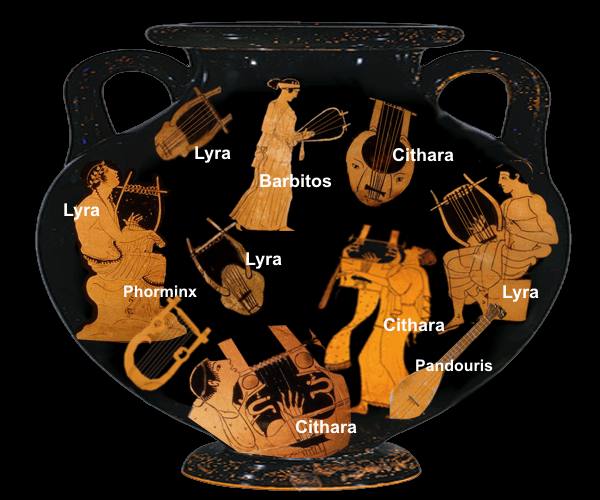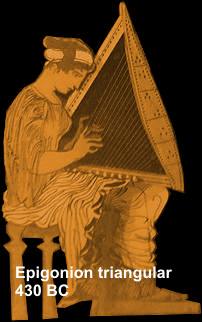
Ancient Greek Instruments
Stringed instruments (Plucked): Cithara, Phorminx, Lyra, Epigonion, Barbiton, Pandouris
Graphics and editorial of this page: Nikolaos Ioannidis --N. Ioannidis is a composer, musicologist, multi-instrumentalist performer, media theorist, and digital media creative producer (BA Music & Media Studies, MA Digital Media Studies, PhD Musicology) , who is researching ancient Greek music and its relationship with all musical cultures that have been subject to the classical Greek cultural influence.
Audio samples of his performances with reconstructed ancient instruments are available online at "The Music of Ancient Greeks - Early Epic and Lyrical Poetry" and "Music and Religion"

Click to see a replica of an ancient Cithara, and a replica of an ancient Lyra, which were used in the recording of these two albums
 v
|
Kithara Lyra: originally called Chelys, because of the tortoise shell used as its sound box. According to Nicomachus of Gerasa (Ist cent. AD), the tortoise-shell Lyra was invented by god Hermes, who gave it to Orpheus. "Orpheus taught Thamyris and Linos, and Linos taught Hercules. When Orpheus was killed by the Thracian women, his lyra was thrown into the sea, and washed ashore at Antissa, a city of Lesbos, where it was found by fishermen, who brought it to Terpander, who in turn carried it to Egypt and presented it to the Egyptian priests as his own creation." We don't know how many strings
the original Lyras had. By the time of Terpander (8th-7th
cent. BC) Lyra was a seven stringed instrument and from
many ancient sources we know that this type remained in
use for a long time during the classical period. The
addition of an eighth string in the 6th century BC is
credited by Nicomachus of Gerasa to Pythagoras. By the
fifth century there were Lyras with anything from 9 to 12
strings. The strings (neura) were made of animal gut of
sinew, but there are also references of strings made of
linen or hemp. Cithara plucked instrument with 5 strings originally, but later with as many as 12 strings. Cithara was bigger than the Lyra and it was the principal concert instrument played by professional musicians, the citharodes. According to Plutarch, cithara was designed by Cepion, a student of Terpander. Many instrument names like guitar, cittern, zither etc. derive from the word cithara. Barbitos or Barbiton is an instrument of the Lyra family and resembles a Lyra, but it has longer arms and narrower sound box. Musicians of the School of Lesbos, like Alcaeus and Sappho, are frequently depicted in vases playing the Barbitos. Phorminx probably the oldest of the Cithara type instruments. From references in ancient sources (Homer, Hesiod, Aristophanes) we know that Phorminx was richly decorated with gold and ivory, and accompanied the singing of the epic singers called rhapsodes. Epigonion belongs to the psaltery family and it is the instrument with the largest number of strings, sometimes as many as forty (Polydeuces). It may owe its name to the fact that it was played 'on the knee' - Greek 'epi gonu', or maybe because its inventor was someone named Epigonus. Pandouris
or pandourion, also called trichord because it had three
strings, is |
|
© Copyright 1999 - PRESENT: Homo Ecumenicus | All Rights Reserved.
Reproduction or
use in any manner of editorial, pictorial, audio-visual, or other
content from this site is prohibited without express written
permission from Homo Ecumenicus. To obtain a license for
commercial use of files on this site (audio files, mid files,
texts, essays, articles, video clips, animations etc.) send email
to ![]()